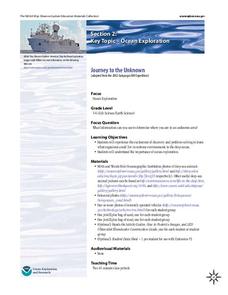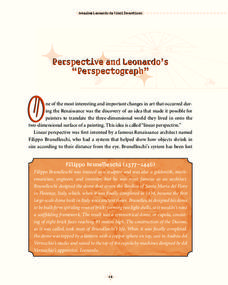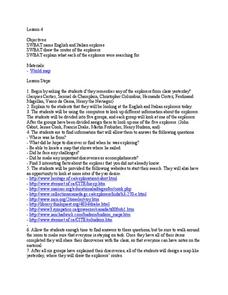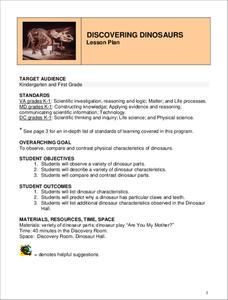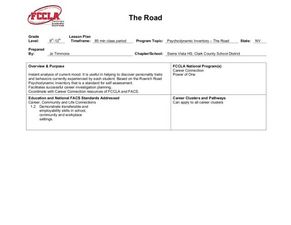Curated OER
Invisible Life
By setting up an aquarium in the classroom, learners are able to describe some macroscopic and microscopic organisms that are found inside. This well-designed, and educationally rich lesson requires pupils to use microscopes to view...
Desert Discoveries
What's the Buzz on Native Bees?
Young biologists describe the different types of bees that are native to the Sonoran Desert. They look at the nesting and feeding requirements of the insects, and study how they are able to pollinate many plants found in the environment....
K12 Reader
The Scientific Method
Introduce the scientific method with a reading comprehension activity. Have kids read a few paragraphs that describe the process of making a hypothesis, gathering evidence, and taking notes that will support the experiment.
K12 Reader
Eratosthenes: Geographer and Mathematician
Mathematicians can be famous, too! Introduce your class to Eratosthenes with a reading passage. After they complete the passage, learners respond to five questions, some of which require opinions and others reading comprehension skills.
Curated OER
Equal Differences Over Equal Intervals 1
Learners explore linear functions concretely using tables of values in a cooperative task. The concept of the values of linear functions changing by equal differences over equal intervals of one is emphasized. Learners will discover...
American Chemical Society
Isolation of Phytochrome
Why do soybean plants that are planted weeks apart in the spring mature simultaneously in the fall? Four independent activities cover the history of phytochrome research, scientist collaboration, the electromagnetic spectrum, and...
NOAA
Journey to the Unknown
What's it like to be a deep-sea explorer? Tap into the imaginations of your fifth and sixth graders with a vivid lesson, the second part of a six-part adventure. Learners close their eyes and submerge themselves in an expedition aboard...
Royal Society of Chemistry
Organic Molecules Day—Chemistry Outreach
In search of an organic lab that employs real-life techniques and analysis methods? Groups carry out the nitration of methyl benzoate, then attempt to determine the number and location of the nitro groups added to the benzene ring....
The New York Times
Perspective and Leonardo’s “Perspectograph”
Filippo Brunelleschi's invention of linear perspective during the Renaissance was further developed by his apprentice, a young artist named Leonardo da Vinci. Now modern artists can give da Vinci's famous perspectograph a try...
Population Connection
Meeting Human Needs
How to meet the needs of people around the globe—a question many ask. The fifth in a six-part series about human population and its effects on the globe, the eye-opening lesson includes discussion, a homework activity, and an in-class...
Curated OER
Social Studies: Debating Aid to Micronesia
Students simulate a debate about continued U.S. aid to the Federated States of Micronesia. In two large groups, they research the history of Micronesia and how it was affected by colonization and trusteeship. After the debate, students...
Curated OER
Explorers
Students research famous explorers. In this exploration age lesson plan, students research the accomplishments of John Cabot, James Cook, Francis Drake, Martin Frobisher, and Henry Hudson. Students use their research...
Curated OER
Human Genetics and Heredity
Learners choose topics for research based on human genetics and heredity. They conduct research via the Internet and write a brief explanation of the milestone in genetics and heredity and attach it to a class timeline. They share...
Curated OER
The Ballad of the Sad Café
Students view the film "The Ballad of the Sad Cafe" and analyze it for stereotypes of mountain and hillbilly communities. They identify and discuss Appalachian values represented in the film and write a report on their observations.
Curated OER
Do the Honeybee Dance!
Students use dances to learn about honeybees and how they communicate. In this honeybee lesson plan, students discuss how bees communicate. Students study diagrams of dances and practice them. Students locate special treats in bags to...
Curated OER
You're History
Students write personal histories. In this historical analysis activity, students explore their own places in history as they read the diaries of others and write their own.
Curated OER
Mapping the Human Genome
Students study DNA and how it was discovered. In this biology lesson students see the effects of mapping the human genome would have.
Curated OER
Lewis and Clark's Journey West: A Timeline Activity
Students complete a scavenger hunt which highlights events on the journey by Lewis and Clark. Using the internet and journals, they identify events on the journey and places them on a timeline. They complete a worksheet as well to end...
Curated OER
Identifying Minerals
Learners compare and constrast a wide variety of minerals and rocks. They test them for streak, luster, color and other characteristics. They view an exhibit and compare their answers to them.
Curated OER
Discovering Dinosaurs
Students investigate the physical characteristics of dinosaurs. They participate in a puppet show, take a field trip to a dinosaur museum, and compare/contrast dinosaur characteristics at the museum.
Curated OER
The Road
Use psychodynamic theory as a part of analyzing a career cluster.The class defines vocabulary words, brainstorms a list of career traits, and completes an online career analysis inventory. They analyze 5 concepts of psychodynamic...
Curated OER
Values and Attitudes
Students examine the Wright brothers' investigation into the principles of flight. Using the internet, they view examples of artifacts and discover how they were always open to new possiblities. They are introduced to the habits they...
Curated OER
Social Studies Review for Grade 5 (5.1)
In this social studies review for grade 5 (5.1) worksheet, 5th graders answer 25 multiple choice questions in a standardized test format about U.S. history.
Curated OER
Bubble-ology
Students observe the visible spectrum while observing light hitting the surface of bubbles. They blow large bubbles and observe how the colors change.






